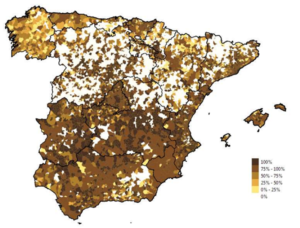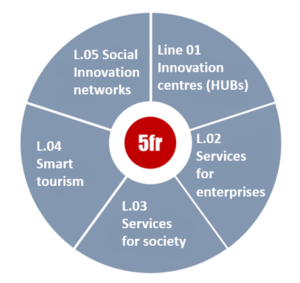The Confederations of businessmen of Cuenca, Soria and Teruel (CEOEs) are the founding entities of the SSPA Network (Sparsely Populated Areas of Southern Europe), a network that brings together the five provinces recognized by the European Union and by its member states, as sparsely populated due to its population density of less than 12.5 inhabitants/km2.
The provinces of Cuenca, Soria and Teruel are characterized by a weak productive environment, especially lacking in technological and innovative activities. The health crisis caused by COVID-19 has accelerated the technological revolution and may become an opportunity for rural areas, thanks to teleworking and possible changes in the scale of social values, but only if access is allowed for rural territories.
Prospective coverage of fixed networks at speeds ≥ 100 Mbps
Broadband coverage report on June 30, 2019 by Secretary of State for Telecommunications and Digital Infrastructures (SETELECO)
CEOEs of Cuenca, Soria and Teruel propose the project ´5 FOR RURAL´ as a part of the Spanish Recovery Plan, seen that includes a strategic transformation of the most unpopulated territories and an increase of their economic and social competitiveness. The project seeks advantage sparsely populated areas, focusing on the enterprises, both in existing and future companies, in their employees, in local administrations, in the population linked to these territories (like tourists) and, of course, all the citizens residing in these areas, but of course benefits would reach the society of the whole country.
We can identify in our project 7 objectives that are:
- To create, accelerate and attract startups focused on collaborative innovation and technological experimentation.
- To promote a leap forward in terms of innovation among companies or clusters already existing in the territory.
- To facilitate digital training for the entire population and to develop an intelligent model of basic services for the rural population.
- To design and promote a new tourism product aimed at the smart tourist of the 21st century.
- To generate a tourism Big Data with which to improve decisions regarding the management and promotion of the tourism phenomenon.
- To create a network of host towns for the effective repopulation of rural areas based on the communication of opportunities, accompaniment and the active involvement of the target population.
- To generate networks to amplify the effects of the project and allow its replication in territories with similar problems.
As a result of this initial approach, 5 FOR RURAL should be understood as an ambitious strategic proposal that integrates 5 lines of work, each one directed primarily at each of the aforementioned territorial actors, but sharing common and complementary work objectives and methodologies.
- To retain and attract talent and startups focused on technological experimentation.
-
- Creation of a digital HUB or innovation centres with:
-
-
- Training and coaching to apply new ideas.
- Development and deployment of applications on the FIWARE platform.
- Innovative and green solutions for the building.
- Development of co-housing models as a housing solution.
- Generation of a Corporate Venture Builder.
-
-
- Creation of a sandbox office, in order to attract companies to test new highly technological business models.
- To innovate in the most traditional productive enterprises.
-
- Implementation of 5G to encourage competitiveness. To do so we will:
-
-
- Detect companies with development potential for the implementation of 5G in production processes, management systems, etc.
- Provide digitizers to accompany companies.
- Have financial advice to promote their projects, establishing a financial support service for R + D + i and digitization in each province.
- Create a Territorial Social Responsibility program.
- Position the territory as an essential node for data storage.
-
3. To offer services for society to be the protagonist of technological change.
-
- Training of digital skills through:
-
-
- A program in primary, secondary and professional training in robotics, process automation and programming.
- An ICT training plan for SMEs with deficiencies.
- A digital literacy plan for people, especially aimed at groups at risk of social and labour exclusion.
-
-
- Digitization of public services, especially:
-
-
- A telemedicine service to provide complementary coverage to chronically ill and elderly people with pathologies.
- A new management models for public lighting and garbage, maximizing investments, optimizing operations and providing administrations with quality information for decision-making.
- An implementation of intelligent systems to minimize security problems in rural environments, such as theft in homes and businesses or responding to civil protection emergencies.
- An implementation of the ATM Network, to guarantee financial inclusion. In addition to the development of a mobile Banking Unit.
-
4. To create smart tourism to become a smart and sustainable destination.
-
- Make these provinces a smart tourism laboratory:
-
-
- Providing Smart points (3D technology, IoT applications) that facilitate a unique tourist experience and enhance, make visible and promote the attractions of the cultural and natural heritage.
- Giving complementary services (electric stations, smart parking lots, smart systems to control the influx of tourists).
-
-
- Identify behavior patterns and make more efficient decision-making in the management and promotion of tourism, generating a tourist Big Data so that administrations, operators, hotels and businesses have the necessary information.
- To bring the territory in all its facets to the new settlers.
-
- Creation of a “Spanish Network of host towns” dedicated to the repopulation of rural areas through:
-
-
- Creation of a digital platform, where the needs of potential residents and the reception opportunities of each municipality are articulated: job offers, entrepreneurship opportunities, housing or training opportunities.
- Comprehensive and individualized reception program. Intended for start-ups, workers with different qualifications, young people who have completed their training stage or are in their last stages, teleworkers or simply, people who are looking for a different living environment from the model offered by large cities.
- Social volunteering program, where the host community acts as a “destination guide” facilitating the construction of the social networks necessary for the roots of new settlers.
- Generational replacement plan, aimed at viable businesses that, lacking relief, see their survival in danger.
- Database of emigrants, to facilitate a possible return to these provinces.
-
Our project does not start from scratch. An example of the strong boost in economic and social competitiveness that incentivizing digitization in rural areas entails can be found in Scotland, with the 5G RuralFirst project. There, the development of 5G technology applied to strategic and identity sectors of that territory has shown that an unfavorable physical, economic and social environment can become attract innovative initiatives and promote a transformative model, beneficial for the whole country.
To finish this description, it is essential to note that the 5 FOR RURAL project is conceived as a collaborative model that seeks to generate powerful networks of technological and social innovation between different territories. As we said before, the project proposes its execution in the provinces of Cuenca, Soria and Teruel, although it was born with the aim of being replicated in other rural territories with similar problems.


